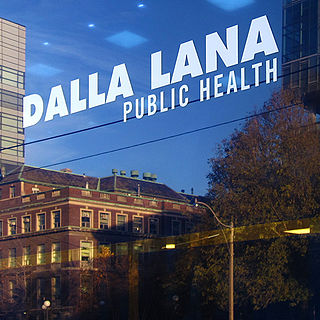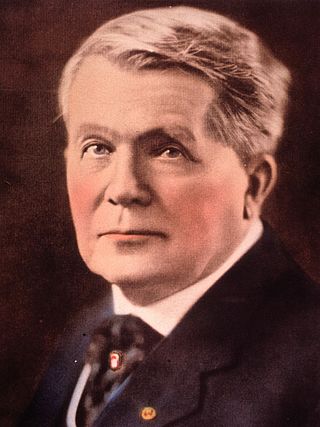
The London School of Hygiene and Tropical Medicine (LSHTM) is a public research university in Bloomsbury, central London, and a member institution of the University of London that specialises in public health and tropical medicine.

Hermann Michael Biggs was an American physician and pioneer in the field of public health who helped apply the science of bacteriology to the prevention and control of infectious diseases. He was born in Trumansburg, New York.

The New York City Department of Health and Mental Hygiene is the department of the government of New York City responsible for public health along with issuing birth certificates, dog licenses, and conducting restaurant inspection and enforcement. The New York City Board of Health is part of the department. Its regulations are compiled in title 24 of the New York City Rules. Since March 2022, the commissioner has been Ashwin Vasan.
David L. Heymann is an American infectious disease epidemiologist and public health expert, based in London.

William Henry Corfield was an English public health physician. Appointed Professor of Hygiene and Public Health at University College London in 1869, Corfield had a major influence on public health and household sanitation in Victorian England before there was extensive knowledge of bacteriology and a clear understanding of infectious disease transmission. He was also an early advocate of land filtration and sewage farms.

Thomas R. Frieden is an American infectious disease and public health physician. He serves as president and CEO of Resolve to Save Lives, a $225 million, five-year initiative to prevent epidemics and cardiovascular disease.
The American Society of Tropical Medicine and Hygiene (ASTMH) is an Arlington, Virginia-based non-profit organization of scientists, clinicians, students and program professionals whose longstanding mission is to promote global health through the prevention and control of infectious and other diseases that disproportionately afflict the global poor. ASTMH members work in areas of research, health care and education that encompass laboratory science, international field studies, clinical care and country-wide programs of disease control. The current organization was formed in 1951 with the amalgamation of the American Society of Tropical Medicine, founded in 1903, and the National Malaria Society, founded in 1941.
Domestic medicine or domestic health care is the behavioral, nutritional and health care practices, hygiene included, performed in the household and transmitted from one generation to the other.

Joseph James Kinyoun was an American physician and the founder of the United States' Hygienic Laboratory, the predecessor of the National Institutes of Health.

Lawrence Francis Flick (1856–1938) was an American physician who pioneered research and treatment of tuberculosis. He was influential as an author, lecturer, and historian. He is a co-founder of the National Association for the Study and Prevention of Tuberculosis and was the first to advocate its formation as early as 1898.

Sigard Adolphus Knopf was a Kingdom of Prussia-born American physician.

Sir Arthur Newsholme was a leading British public health expert during the Victorian era.

Dalla Lana School of Public Health is the school of public health at the University of Toronto. It was founded in 1927, and was home for 50 years to Connaught Laboratories, a manufacturer of vaccines, insulin, and many other pharmaceutical products. Having grown to be the largest cluster of public health scholars in Canada, the school was revitalized in 2008 with the support of a major gift from the Dalla Lana family.

Joseph Nathaniel McCormack was an American surgeon, a leader in several national medical organizations and a member of the Kentucky General Assembly. He served as executive officer of the Kentucky State Board of Health for thirty years and he led the reorganization of the American Medical Association (AMA) during its formative years of 1900 to 1911. James Burrow, historian of the AMA, has written that McCormack was "the most influential political leader of the profession in the Progressive Era, or perhaps in the AMA's entire history." McCormack served for six years as president of the Association of State and Territorial Health Officials and for two years as president of the Federation of State Medical Boards. In 1907 the American Association for the Advancement of Science included him in its list of the 100 most influential leaders in the fields of medicine, public health, science and social reform.

Algernon Brashear Jackson (1878-1942) was a prominent African American physician, surgeon, writer, and columnist who contributed profoundly to the National Negro Health Movement, an organization which sought to uplift African Americans by educating them on preventative medicine and public health. He was also well known for being a founding member of the Sigma Pi Phi fraternity and pioneering an effective treatment for rheumatism.
Mary Sherwood was a physician, educator, and spokesperson for preventive medicine, public health, women's health, childcare. She played a vital role in many women's organizations and clubs, as well as contributed to many medical social movements in Maryland and Baltimore.

Martha Tracy served as dean of the Woman's Medical College of Pennsylvania (WMCP) from 1917 to 1940, leading the institution through the Great Depression. She created a department of preventive medicine within the college and was the first professor of preventive medicine at WMC.

Dr Joseph Friedrich ("Fritz") Weleminsky, was a physician, a scientist and a privatdozent in Hygiene at the German University, Prague who, in the early 20th century, created an alternative treatment for tuberculosis, tuberculomucin Weleminsky.

Dave Ashok Chokshi is an American physician and former public health official who served as the 43rd health commissioner of New York City. He was the first health commissioner of Asian descent. Chokshi previously served as the inaugural chief population health officer for NYC Health + Hospitals and as a White House fellow in the United States Department of Veterans Affairs. Currently he is a practicing physician at Bellevue Hospital and the inaugural Sternberg Family Professor of Leadership at the Colin Powell School for Civic and Global Leadership, part of the City College of New York.

Harriet Louise Hargrave Hartley, also written as Harriett L. Hartley, was an American physician, public health official, and college professor. The Harriet L. Hartley Conservation Area in Maine occupies land she once owned, and is named for her.
















